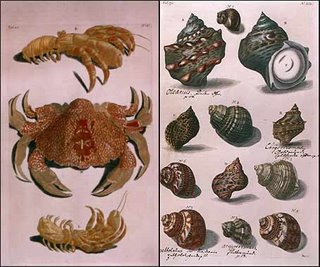
Peter Leyden has a prediction for 2007:
American politics is entering a transformative period that is roughly analogous to a handful of other periods in American history....What happened then, and is happening now, is that fundamental economic and social restructuring gets to the point where the old politics don’t work, particularly conservative formulas that look backward. The new world’s new challenges go unsolved, and problems build to the breaking point – then a new politics begins.That's pretty accurate, it seems to me. I doubt the "new politics" will go quite as far in the direction of sanity or morality as I'd like, but our biggest hurdle has always been noticing - or admitting, I should say - that there's a problem. I think it's fair to say that 2006, we made some impressive progress in that regard.
I also think it’s going to be very hard to be a climate denialist in 2007, and that the collapse of this industry is going to have uncomfortable repercussions for free-market fanatics in general. These people are long overdue for the ash-heap, God knows, because…well, because they’re incredibly fucking stupid, basically. Our conservatarian overlords have held back progress for decades, largely out of ill will, but I don’t think they’re going to be able to manage it for much longer. Not because Americans are suddenly going to start hugging trees or worshipping dirt, but because we’ve reached a point where it’s become obvious even to the timid, stolid "visionaries" who make up corporate America that there’s at least as much money to be gained by solving problems as by pretending they don’t exist.
Apropos of which, the Bush administration is talking about listing the polar bear as a threatened species:
The Bush administration has decided to propose listing the polar bear as threatened under the Endangered Species Act, putting the U.S. government on record as saying that global warming could drive one of the world's most recognizable animals out of existence.I hesitate to speculate on the logic behind this proposal, or how it might play out in terms of policy. But if it goes through, I think it’s safe to say it’ll be an epochal decision.
The same goes for Wal-Mart’s tentative plan to install solar power in stores in five states:
Wal-Mart doesn't mention a specific purchase size, but my sources tell me that the company could put solar on as many as 340 stores in the next few years. Assuming that each store utilized about 300 kilowatts of solar panels (it could be as much as 500 kilowatts), we're talking roughly 100 megawatts of solar. To put that into perspective, the solar system currently being installed at Google headquarters in California -- the largest single corporate solar installation in history -- is 1.6 MW, about 1/60th the size.Meanwhile, the Democrats have come up with a nice way to ring in the new year:
House Democrats in the first weeks of the new Congress plan to establish a dedicated fund to promote renewable energy and conservation, using money from oil companies. That's only one legislative hit the oil industry is expected to take next year as a Congress run by Democrats is likely to show little sympathy to the cash-rich, high-profile business.Let’s hope they’re serious about it, and can actually pull it off. It probably wouldn’t hurt to ask your rep to support the plan.
A new study suggests that reducing infections in intensive care units is not all that hard to do:
Hospitals will quickly slash the rate of common, costly and potentially lethal catheter-related bloodstream infections in their intensive care units (ICUs) by using cheap, low-tech, common-sense measures like hand washing, timely removal of unneeded catheters, and use of sites other than the groin to place lines when possible, according to a report from safety experts at Johns Hopkins in the Dec. 28 issue of the New England Journal of Medicine.Amazing, eh? And remember: You heard it here first!
"There's just no reason any more not to do these relatively simple things," says Peter Pronovost, M.D., professor of medicine and medical director of Hopkins' Center for Innovation [!] in Quality Patient Care….
Wisconsin has had some luck with re-establishing the trumpeter swan:
Successful efforts to re-establish trumpeter swans in Wisconsin have resulted in a flock that last summer numbered more than 500 swans. Now these majestic, but still endangered, birds are expanding their range into the central and even southern parts of the state.Numbers of whooping crane and ruffled grouse are also increasing.
In Washington, the Nature Conservancy sealed a deal with local farmers to flood fields for the benefit of waterfowl:
Each man has committed about 70 acres to this project, which is called Farming for Wildlife. A third of that land will be flooded with a few inches of fresh water in the spring, fall and winter. This will create shallow ponds to entice thousands of birds, some of them on their way to and from the Arctic, to stop and snack on tiny invertebrates and worms as they travel along the Pacific flyway.Also in Washington, the destruction of the Goldsborough Dam has done wonders for the salmon population:
The farmers see the Nature Conservancy’s willingness to pay them as an acknowledgment that they should not be expected to sacrifice their land or their living for wildlife. This approach effectively turns shorebirds into another crop to manage, instead of grounds for a lawsuit."
Along the way, scientists are getting a glimpse of what can happen when a dam, albeit a small one, is demolished: As fish gradually reclaim their former habitat, Goldsborough Creek is becoming a more important source of salmon for the southern tip of Puget Sound.A small village in Trinidad has managed to prevent Alcoa from siting a smelter on their farmland:
Though small, this dam is a harbinger of things to come in the Northwest. Seven dams in Washington and Oregon, including two big dams on the Elwha River in Olympic National Park, are slated for demolition in the next five years.
Bowing to a year of stormy protests, Prime Minister Patrick Manning said the government was scrapping plans to open an industrial park in Cap-de-Ville, in a sleepy, southeast farming region where the US$1.5 billion smelter was to have been located.The new plan is to site the smelter offshore. But something tells me it may run into some snags:
"We have a consensus. We will protest," said Suresh Seepersad, a spokesman for the Otaheite Fishermen's Association. "As fishermen and residents of the area, we will be ready to die for this cause," he said.Alcoa has also been obliged to shut down a polluting plant in Texas:
The consent decree stemming from the 2002 federal court lawsuit filed by Neighbors For Neighbors Inc., Environmental Defense and Public Citizen Inc. citing air pollution from Alcoa’s aging Sandow Power Plant, required Alcoa to upgrade the power plant, shut down the power plant or decommission the plant and rebuild - the option Alcoa chose....Researchers in the UK are about to commence human testing of a universal flu vaccine. Caveat lector is my advice, but there’s no reason you can’t keep your fingers crossed. If all else fails, the town of Croydon is seeking alternative strategies for disposing of corpses:
BURIALS in unmarked graves with bio-degradable coffins may be the only way to beat pollution and a chronic lack of graveyard space in Croydon.Southeast Asia is getting tough on wildlife poachers:
Long outgunned and outmaneuvered by smuggling gangs, the 10-member Association of Southeast Asian Nations agreed last year to form the Wildlife Enforcement Network to combat a black-market trade in plants and animals that generates $10 billion in revenue each year -- third behind illicit dealings in weapons and drugs.Apparently, the USA has contributed $2.7 million to anti-smuggling groups. That’s good, but more would be better. In addition to being reprehensible and stupid, this trade poses a serious public health risk.
Speaking of Southeast Asia, a plant native to Ambon may be a valuable weapon against diarrhea (which, as I always feel compelled to mention, kills 1.8 million children per year):
A unique Mayo Clinic collaboration has revived the healing wisdom of Pacific Island cultures by testing a therapeutic plant extract described in a 17th century Dutch herbal text for its anti-bacterial properties. Early results show that extracts from the Atun tree effectively control bacteria that can cause diarrhea, as claimed by naturalist Georg Eberhard Rumpf, circa 1650. He documented his traditional healing methods in the book Ambonese Herbal.Rumphius is an endlessly fascinating character, by the way, and the story of how his work was written and published is truly harrowing:
After going blind in 1670, Rumphius continued work on his six-volume manuscript with the help of others….In 1687, with the project nearing completion, the illustrations were lost in a fire. Persevering, Rumphius and his helpers first completed the book in 1690, but the ship carrying the manuscript to the Netherlands was attacked by the French and sank, forcing them to start over from a copy that had fortunately been retained. The Herbarium Amboinensis finally arrived in the Netherlands in 1696. However, "the East India Company decided that it contained so much sensitive information that it would be better not to publish it." It finally appeared in 1741, thirty-nine years after Rumphius's death.The Ambonese Curiosity Cabinet is beautifully written and illustrated; it’s one of my favorite books of natural history.

You can get it cheap from Amazon sellers, or – sad to say – in bookstores that carry remaindered titles.
The picture at the top is titled "Solar Effect in the Clouds – Ocean" (1856). It's part of a glorious online exhibition of photographs by Gustave Le Grey. I was also very impressed, this week, with an exhibition called The Human Factor, which showcases "The Industrial Life Photograph Collection" at the Harvard Business School's Baker Library. Here's a 1934 photo of silverware being electroplated:

BibliOdyssey has made a last-minute bid for best post of the year with a collection of images of stilt walkers. Here’s an evocative sample:

Almost as remarkable as this illustration is the title of the book whence it came: Across the Great Saint Bernard: the Modes of Nature, and the Manners of Man (A.Sennett/H.Percival, 1904). That’s right up there with John Stewart’s Roll of a Tennis Ball Through the Moral World (1812).
Last, in administrative news, I've been trying to post more frequently at Injudicious Gardening, which is my online commonplace book. I've also created a blog called Dime Geography as a dumping-ground for photos I've taken while on my appointed rounds. Not much there at the moment, but I hope to do more with it in the coming year. Oh, and Abie will be glad to know that I intend to switch to the new Blogger over the weekend, which'll apparently allow me to use tags.
1 comment:
The battle between alternative healing and mainstream medicine continues as both methods present various benefits. What is more important is we focus on the bottom line, which is the ultimate restoration of good healthhttp://www.keyinsight.com/Healing-the-Luminous-Body-The-Way-of-the-Shaman-p-174.html
Post a Comment